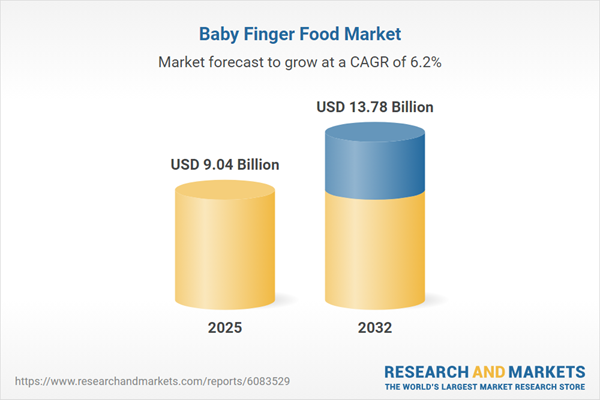Speak directly to the analyst to clarify any post sales queries you may have.
The baby finger food market is evolving rapidly, shaped by heightened consumer expectations, regulatory updates, and demands for convenience and transparency. Senior decision-makers are reassessing strategies to secure a competitive edge amid shifting consumer and industry priorities.
Market Snapshot: Baby Finger Food Market Growth and Trends
The global baby finger food market expanded from USD 8.50 billion in 2024 to USD 9.04 billion in 2025, with projections indicating a rise to USD 13.78 billion by 2032 at a CAGR of 6.22%. This growth is primarily driven by a greater emphasis on nutrition and convenience, prompting manufacturers to revisit ingredient profiles and packaging advancements. Strategic attention to product differentiation, particularly through ingredient transparency and innovative branding, is accelerating competition. While brands invest in advanced packaging, evolving family demographics and dietary preferences fuel continuous product transformation. These shifts drive the need for deeper trust and stronger brand-consumer relationships across regions and distribution channels.
Scope & Segmentation of the Baby Finger Food Market
Thorough segmentation enables companies to align product development and market reach with evolving consumer and regulatory demands. This report examines the baby finger food market across multiple key dimensions:
- Product Types: Includes biscuits and rusks spanning gluten-free, rice-based, and whole grain varieties; cereal puffs with multi cereal, oat, and rice formulations; fruit melts in flavors such as apple and banana; teething rings in edible and silicone formats; and wafers in options like chocolate and vanilla.
- Distribution Channels: Covers convenience stores, online retail encompassing direct-to-consumer and broader ecommerce, specialty stores, as well as supermarkets and hypermarkets operating within organized retail models.
- Age Groups: Offers segmentation by developmental stage, featuring products for 6–12 months, 12–24 months, and over 24 months, supporting age-appropriate nutrition and texture.
- Packaging Types: Analyzes bulk, multi-pack, and single serve options to cater to household preferences and individual needs.
- Ingredient Source: Distinguishes between organic and non-organic product lines, reflecting diverse consumer expectations for health and sourcing integrity.
- Geographic Regions: Provides in-depth coverage of the Americas, Europe, the Middle East and Africa, and Asia-Pacific, highlighting market-specific demands and regional consumption patterns.
- Notable Market Participants: Includes global and regional brands such as Gerber Products Company, The Beech-Nut Nutrition Company, The Hain Celestial Group, The Kraft Heinz Company, PLUM Organics, Sprout Foods, Happy Family Organics, Hero International AG, Bellamy’s Organic Group, and Else Nutrition Holdings Inc.
Key Takeaways: Strategic Insights for Senior Decision-Makers
- Heightened consumer focus on ingredient transparency and safety prompts manufacturers to develop plant-based, allergen-aware, and fortified product lines addressing family priorities for health and trust.
- Millennial buying behaviors are reshaping retail dynamics, fostering growth in subscription services and direct-to-consumer digital platforms for greater convenience and improved brand engagement.
- Investment in recyclable and compostable packaging strengthens brand appeal among eco-conscious families, increasingly influencing purchasing decisions and competitive positioning.
- Regional market differences call for flexible strategies; Asia-Pacific sees acceleration from urbanization and changing incomes, while markets in North America and Europe place emphasis on compliance and premiumization.
- Tailored segmentation by age group and packaging bolsters relevance, supporting families with specific nutritional, textural, and portion control preferences, and encouraging trial through variety.
- Digital engagement, including influencer campaigns and content marketing, is rapidly building consumer trust, with leading players leveraging social platforms to drive adoption of new products.
Tariff Impact: Operational Implications in 2025
United States tariffs introduced in 2025 are reshaping ingredient and packaging import routes for the baby finger food market. Businesses are optimizing local sourcing, revising their supplier networks, and integrating digital analytics and automation to manage operational costs and supply chain reliability. Transparent adaptation to tariff changes is now a differentiator, helping maintain distribution continuity and managing volatility in trade environments.
Methodology & Data Sources
This research employs in-depth primary interviews with industry leaders, nutrition specialists, and caregiver panels, augmented by regulatory filings and industry publications. Quantitative surveys, scenario modeling, and data triangulation ensure reliable findings and actionable recommendations for B2B stakeholders.
Why This Report Matters for Business Leaders
- Supports leadership foresight by outlining actionable strategies aligned with shifting consumer attitudes and retailer demands in the baby finger food market.
- Clarifies priority segments and optimal distribution channels to help refine product development and enhance go-to-market execution on a global scale.
- Equips organizations to anticipate supply chain disruptions and meet compliance expectations, sustaining growth in established and expanding categories.
Conclusion
Senior leaders in the baby finger food market face a landscape defined by dynamic innovation, evolving demographics, and operational complexity. Adapting through strategic product, sourcing, and digital initiatives is crucial for long-term business resilience and growth.
Table of Contents
3. Executive Summary
4. Market Overview
7. Cumulative Impact of Artificial Intelligence 2025
Companies Mentioned
The companies profiled in this Baby Finger Food market report include:- Gerber Products Company
- The Beech-Nut Nutrition Company
- The Hain Celestial Group, Inc.
- The Kraft Heinz Company
- PLUM Organics, LLC
- Sprout Foods, Inc.
- Happy Family Organics, LLC
- Hero International AG
- Bellamy’s Organic Group Limited
- Else Nutrition Holdings Inc.
Table Information
| Report Attribute | Details |
|---|---|
| No. of Pages | 198 |
| Published | October 2025 |
| Forecast Period | 2025 - 2032 |
| Estimated Market Value ( USD | $ 9.04 Billion |
| Forecasted Market Value ( USD | $ 13.78 Billion |
| Compound Annual Growth Rate | 6.2% |
| Regions Covered | Global |
| No. of Companies Mentioned | 11 |









